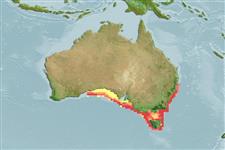Common names from other countries
Environment: milieu / climate zone / depth range / distribution range
Ekologi
marina djupbottenlevande; djupintervall 5 - 640 m (Ref. 6871), usually 100 - 300 m (Ref. 114953). Temperate; 30°S - 44°S, 126°E - 154°E (Ref. 114953)
Southeast Indian Ocean and Southwest Pacific: Australia (including New South Wales, South Australia, Victoria and Tasmania).
Size / Vikt / Age
Maturity: Lm ? range ? - ? cm
Max length : 47.0 cm TL hane/ej könsbestämd; (Ref. 6871)
Found on sand or mud bottoms, occasionally near rocky reefs (Ref. 12951). Feeds on amphipods, shrimp, and worms (Ref. 12951). Produces 1-8 (normally 3) pups during each gestation. Both sexes mature at ca. 20-21 cm TL; born at 9-12 cm TL (Ref. 114953)
Life cycle and mating behavior
Maturities | Reproduktion | Spawnings | Egg(s) | Fecundities | Larver
Paxton, J.R., D.F. Hoese, G.R. Allen and J.E. Hanley, 1989. Pisces. Petromyzontidae to Carangidae. Zoological Catalogue of Australia, Vol. 7. Australian Government Publishing Service, Canberra, 665 p. (Ref. 7300)
IUCN Red List Status (Ref. 130435)
CITES (Ref. 128078)
Not Evaluated
Threat to humans
Harmless
Human uses
Verktyg
Special reports
Download XML
Internet-källor
Estimates based on models
Preferred temperature (Ref.
115969): 11.7 - 16.6, mean 14.2 (based on 82 cells).
Phylogenetic diversity index (Ref.
82804): PD
50 = 0.5312 [Uniqueness, from 0.5 = low to 2.0 = high].
Bayesian length-weight: a=0.01175 (0.00476 - 0.02897), b=2.88 (2.66 - 3.10), in cm Total Length, based on LWR estimates for this (Sub)family-body shape (Ref.
93245).
Trofisk nivå (Ref.
69278): 3.3 ±0.48 se; based on food items.
Resiliens (Ref.
120179): Låg, lägsta populationsfördubblingstid 4,5-14 år (Assuming fecundity<100).
Fishing Vulnerability (Ref.
59153): Moderate vulnerability (37 of 100).
